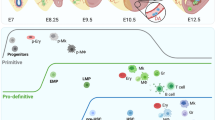Summary
We describe the results of cell transplantation experiments performed to investigate mesodermal lineages in Drosophila melanogaster, particularly the lineages of the somatic muscles, the visceral muscles and the fat body. Cells to be transplanted were labelled by injecting a mixture of horseradish peroxidase (HRP) and fluorescein-dextran (FITC) in wild-type embryos at the syncytial blastoderm stage. For transplantation cells were removed from the ventral furrow, 8–12 min after the start of gastrulation, and individually transplanted into homotopic or heterotopic locations of unlabelled wild-type hosts of the same age. HRP labelling in the resulting cell clones was demonstrated histochemically in the fully developed embryo; histotypes could be distinguished without ambiguity. Mesodermal cells were already found to be committed to mesodermal fates at the time of transplantation. They developed only into mesodermal derivatives and did not integrate in non-mesodermal organs upon heterotopical transplantation. No evidence was found for commitment to any particular mesodermal organ at the time of transplantation. The majority of somatic muscle clones contributed cells to only one segment. However, clones were not infrequently distributed through two or even three segments. Clones of fat body cells were generally restricted to a small region. However, cells of clones of visceral musculature were widely distributed. With respect to the proliferative abilities of transplanted cells the clones were difficult to interpret due to the syncytial character of the somatic musculature and the fact that the organization of the other organs is poorly understood. Evidence from histological observations of developing normal embryos indicates only three mitoses for mesodermal cells. Clones larger than seven cells were not found when embryos were fixed previous to germ-band shortening; larger clones were found in the fat body and visceral musculature after fixing the embryos at the end of organogenesis. Quantitative considerations suggest that a few mesodermal cells might perform more than three mitoses.
Similar content being viewed by others
References
Bodmer R, Jan YN (1987) Morphological differentiation of the embryonic peripheral neuron in Drosophila. Roux's Arch Dev Biol 196:69–77
Campos-Ortega JA, Hartenstein V (1985) The embyonic development of Drosophila melanogaster. Springer, Berlin Heidelberg New York Tokyo
Fraser SE, Bryant PJ (1985) Patterns of dye coupling in the imaginal wing disk of Drosophila melanogaster. Nature (Lond) 317:533–536
Gimlich RL, Braun J (1985) Improved fluorescent compounds for tracing cell lineage. Dev Biol 109:509–514
Hartenstein V, Campos-Ortega JA (1985) Fate-mapping in wildtype Drosophila melanogaster. I. The spatio-temporal pattern of embryonic cell divisions. Wilhelm Roux's Arch 194:181–195
Illmensee K (1978) Drosophila chimeras and the problem of determination. In: Gehring WJ (ed.) Genetic mosaics and cell differentiation. Springer, Berlin Heidelberg New York, pp 51–69
Kauffman SA (1980) Heterotopic transplantation in the syncytial blastoderm of Drosophila: Evidence for anterior and posterior commitments. Wilhelm Roux's Arch 189:135–145
Lawrence PA (1982) Cell lineage of the thoracic muscles in Drosophila. Cell 29:493–503
Lawrence PA, Brower DL (1982) Myoblasts from Drosophila wing disks can contribute to developing muscles throughout the fly. Nature (Lond) 295:55–57
Lawrence PA, Johnston P (1982) Cell lineage of the Drosophila abdomen: the epidermis, oenocytes and ventral muscles. J Embryol Exp Morphol 72:197–208
Lawrence PA, Johnston P (1986) Observations on cell lineage of internal organs of Drosophila. J Embryol Exp Morphol 91:251–266
Lo CW, Gilula NB (1979) Gap junctional communication in the preimplantation mouse embryo. Cell 18:399–409
Poulson DF (1950) Histogenesis, Organogenesis and differentiation in the embryo of Drosophila melanogaster Meigen. In: Demerec M (ed). The genetics and biology of Drosophila. Wiley, New York, pp 168–274
Sauer E (1954) Keimblätterbildung und Differenzierungsleistungen in isolierten Eiteilen der Honigbiene. Wilhelm Roux's Arch 147:302–354
Simcox AA, Sang JH (1983) When does determination occur in Drosophila embryos? Dev Biol 97:212–221
Sonnenblick BP (1950) The early embryology of Drosophila melanogaster. In: Demerec M (ed.). The genetics and biology of Drosophila. Wiley, New York, pp 62–167
Technau GM (1986) Lineage analysis of transplanted individual cells in embryos of Drosophila melanogaster. I. The method. Roux's Arch Dev Biol 195:389–398
Technau GM, Campos-Ortega JA (1985) Fate-mapping in wild type Drosophila melanogaster. II. Injections of horseradish peroxidase in cells of the early gastrula stage. Wilhelm Roux's Arch 194:196–212
Technau GM, Campos-Ortega JA (1986a) Lineage analysis of transplanted individual cells in embryos of Drosophila melanogaster. II. Commitment and proliferative capabilities of neural and epidermal progenitors. Roux's Arch Dev Biol 195:445–454
Technau GM, Campos-Ortega JA (1986b) Lineage analysis of transplanted individual cells in Drosophila melanogaster. III. Commitment and proliferative capabilities of pole cells and midgut progenitors. Roux's Arch Dev Biol 195:489–498
Weir MP, Lo CW (1984) Gap-junctional communication compartments in the Drosophila wing imaginal disk. Dev Biol 102:130–146
Author information
Authors and Affiliations
Rights and permissions
About this article
Cite this article
Beer, J., Technau, G.M. & Campos -Ortega, J.A. Lineage analysis of transplanted individual cells in embryos of Drosophila melanogaster . Roux's Arch Dev Biol 196, 222–230 (1987). https://doi.org/10.1007/BF00376346
Received:
Accepted:
Issue Date:
DOI: https://doi.org/10.1007/BF00376346




